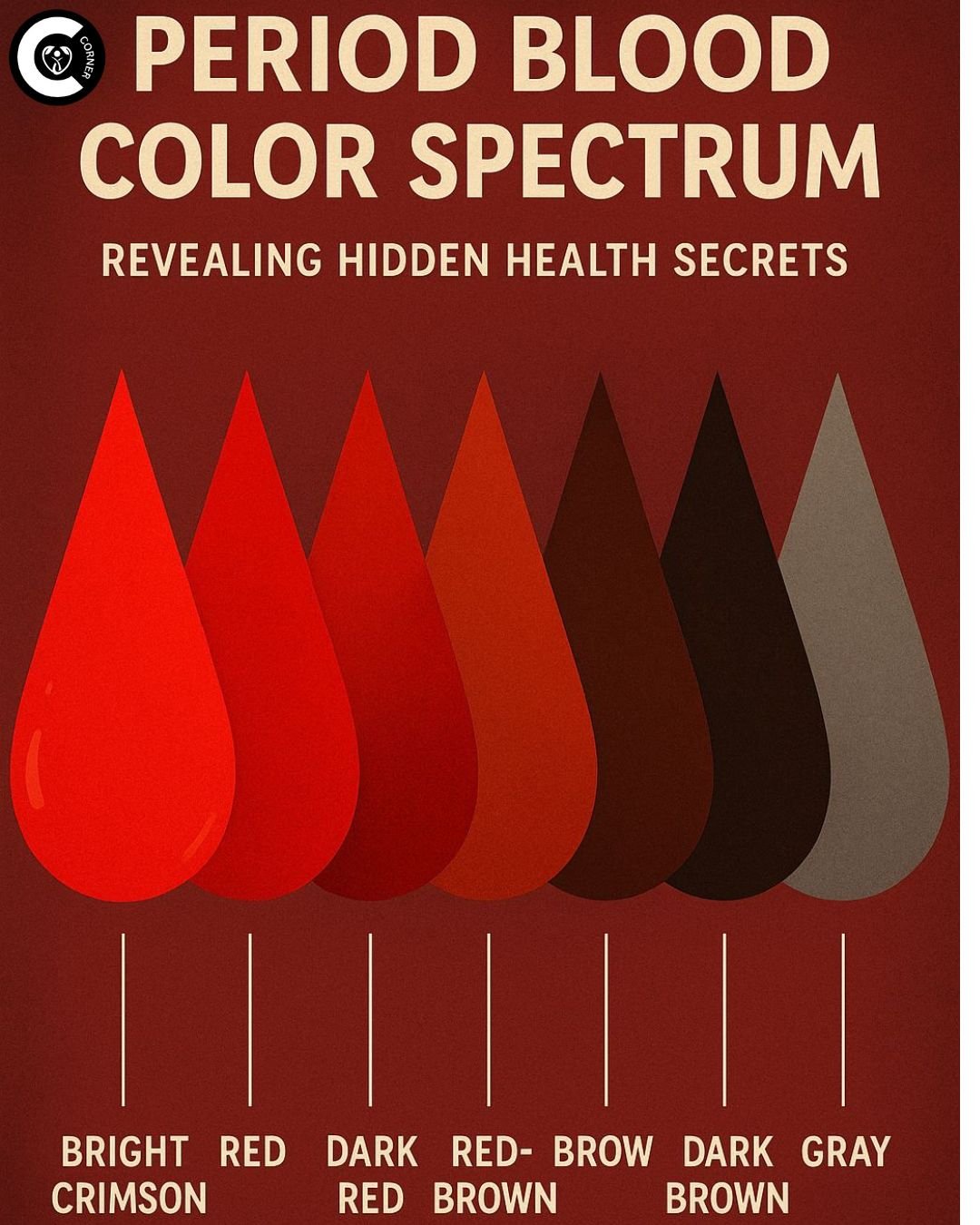Your monthly period is more than just a pain; it’s a strong, visible statement from your body about how well you are on the inside. Many people only care about how regular their cycles are, but the color of period blood can tell you a lot about your hormone balance, uterine health, and overall health. If you notice that your period’s color changes from brilliant red to dark brown, pink, or even orange, it could be a sign that something is wrong or that everything is going as it should. This in-depth book goes into great detail on the interesting meanings of period colors, which will help you comprehend what your body is trying to tell you each month. We’ll look at the science behind the colors, clear up any worries you may have, and let you know when a color shift means you should talk to your doctor.
Why Does Period Blood Color Vary?
Blood from a period isn’t just new blood from a cut. It is a one-of-a-kind mix of blood, uterine tissue, cervical mucus, and vaginal fluids. The color of it fluctuates mostly because of two main things:
- Oxidation: When blood comes into contact with air, it turns dark, just like a sliced apple does. When blood stays in the uterus longer before being expelled, it oxidizes, changing from brilliant red to darker colors like brown or even black.
- Flow Rate & Timing: Blood that flows swiftly at the start of your period frequently seems brighter since it leaves the body quickly and doesn’t oxidize much. A slower flow, which is frequent at the start or conclusion of your cycle, gives oxidation more time to happen, which makes the colors darker.
Understanding this normal variance helps put the meaning of the periodic color in context without causing panic right away. Hormonal changes, health problems, infections, or even stress can change the color, therefore, it’s important to be aware of these things.
What does Each Period’s Blood Color Mean?
Let’s talk about the different colors of period blood and what they indicate. We’ll also talk about when they’re usually normal and when they can mean something is wrong.
Bright Red Period Blood: The Sign of Active Flow
What it looks like
It looks like bright, fresh cranberry juice red.
What it usually means
This is the color that shows that your menstrual flow is consistent and active. It is most frequent during the heaviest days (days 2-3) of your period. The vivid red color shows that the blood is moving quickly from the uterus and being pushed out quickly, which doesn’t give it much time to oxidize. This is usually seen as a sign of normal, healthy shedding.
When it might be a concern
If you bleed bright crimson outside of your normal menstrual cycle, such as between periods or for more than seven days, you should see a doctor. This could mean that you have polyps, fibroids, infections (such as cervicitis or pelvic inflammatory disease), early pregnancy problems including miscarriage or ectopic pregnancy, or, less often, some malignancies. Hormonal imbalances, especially low progesterone, can also make you bleed bright red spots that you didn’t expect. If you have a steady, heavy, bright red flow that necessitates a pad or tampon change every hour or two for several hours, you should see a doctor to rule out problems such as bleeding disorders or large fibroids.
Dark Red Period Blood: Slower Flow or End of Cycle
What it looks like
It looks deep burgundy, merlot, or maroon—these colors are darker and richer than bright red.
What it usually means
What it generally means: Dark red blood is very frequent, especially near the end of your period or at the very beginning, before the full flow starts. This color means that the blood has been in the uterus for a little longer, which lets some oxidation happen. You can usually see it on days when the flow is lighter or at night after you’ve been lying down. It may come with a thicker consistency or little clots, which is normal if they are less than the size of a quarter.
When it might be a concern
A sudden change to consistently dark red flow throughout your entire period, especially if it comes with large clots (bigger than a quarter) or a lot more cramping, could mean that something is wrong, like uterine fibroids (which can change the shape of the uterine cavity and slow blood flow) or adenomyosis (where endometrial tissue grows into the uterine muscle wall, causing heavier, darker flow and severe pain). Changes in hormones during perimenopause might also make the flow darker.
Brown or Black Period Blood: The Oxidation Champion
What it looks like
It can be dark chocolate brown, almost black, like tar, or like coffee grounds. It might be thick or sticky.
What it usually means
Don’t worry! This is usually aged blood. Brown or black period blood is blood that has oxidized a lot. It happens most often:
- At the very beginning of your period, when old blood and tissue from the past cycle are being taken out.
- At the conclusion of your period, when the flow slows down.
- As spotted just before your entire flow starts.
For many people, this is a natural component of their menstrual cycle and shows that the body is getting rid of leftover material quickly. People with lighter flows or longer cycles are more likely to have it.
Also Read: How to Overcome Vaginismus
When it might be a concern
If you have brown or black discharge that doesn’t go away after your period, smells bad, or makes you itch, burn, or feel pain in your pelvis, you may want to see a doctor. This could mean that you still have some of the products of conception after a miscarriage or birth, that you have an infection (like bacterial vaginosis or a STI that causes irritation and old blood spotting), or, very rarely, that you have cervical or endometrial cancer (but this is rare and usually comes with other serious symptoms like bleeding after menopause or unusual bleeding patterns). Lochia (bleeding after giving birth) also turns brown or black at some point, which is typical.
Pink Period Blood: Light Flow or Dilution
What it looks like
It appears like light pink, diluted rose, or salmon.
What it usually means
Pink period blood usually means that the flow is lighter and mixed with cervical fluid, which naturally thins the blood. Some such situations are:
- The very beginning or very end of your periods when there isn’t much flow.
- Spotting around ovulation (mid-cycle), which is often caused by a short drop in estrogen.
- People who don’t have really heavy periods.
Low estrogen levels, which can happen during perimenopause, after a lot of activity, or after losing a lot of weight, or while using some hormonal birth control methods like low-dose pills or IUDs, can also cause periods that are always lighter and pinker.
When it might be a concern
If you keep getting pink spots instead of your regular period, it could mean that your estrogen levels are low. This could hurt your bones and your ability to get pregnant if it lasts for a long time. It can also happen in the early stages of pregnancy, when the egg implants itself. If you get pink discharge and it smells bad like fish and itches, it could be bacterial vaginosis. You should talk to a doctor if you have pink spotting that happens all the time and doesn’t have anything to do with your period.
Orange Period Blood: Rare & Often Linked to Infection
What it looks like
Distinctly orange, rusty, or with a hint of yellow.
What it usually means
Orange is less common and usually happens when period blood mixes with cervical fluid that has bacteria in it. The orange color could be caused by the virus itself or by the body’s response to it.
When it might be a concern
- Orange menstrual blood is often linked to vaginal infections. Two main reasons are:
Bacterial Vaginosis (BV) is when the bacteria in the vagina aren’t in the right balance. This can cause orange or greyish discharge, a strong fishy smell (particularly after sex), and sometimes itching or burning. - Trichomoniasis is a sexually transmitted infection (STI) caused by a parasite. It can cause frothy, yellow-green or orange discharge, as well as a strong smell, itching, redness, and painful urination.
Important: If you detect orange discharge, especially if it smells bad, itches, burns, or hurts in the pelvic area, you should visit a doctor right away for diagnosis and treatment. If you don’t pay attention to it, it could cause problems like pelvic inflammatory disease (PID).
Gray Period Blood: A Potential Red Flag for Infection
What it looks like
Grey that is murky, hazy, white, or even mild pinkish-gray.
What it usually means
Grey discharge, especially if it’s thin and watery, is a strong sign of an infection. It isn’t a normal change in the color of menstrual blood.
When it might be a concern
Bacterial Vaginosis (BV) is the most common cause of grey discharge. It usually comes with a strong, unpleasant fishy smell (which is particularly noticeable after sex) and sometimes itching or burning. Bacterial vaginosis (BV) is widespread and can be treated, although it needs antibiotics. Grey discharge can also be a symptom of miscarriage, especially if it happens during pregnancy or when a period is late or skipped and is followed by tissue passing or severe cramping. Grey discharge should always be checked out by a doctor right away to find out what is causing it.
Beyond Color: Understanding Clots, Consistency, and Volume
color is an important sign, but to really understand your period’s health, you should also pay attention to other things:
- Clots: Small, dark red or brown clots that are smaller than a quarter are prevalent, especially on days when the flow is stronger. They are clumps of endometrial tissue mixed with blood. About clots: If you have huge, frequent clots (bigger than a quarter), especially if they are bright red or you soak through a pad or tampon in less than an hour or have considerable discomfort, it could mean that you are having heavy monthly bleeding (menorrhagia). This could be caused by fibroids, polyps, adenomyosis, bleeding disorders, or hormonal imbalances. Needs a medical check-up.
- Consistency: The blood that comes out during your period might be thin and watery or thick and sticky. A thicker flow usually happens on days when the blood is darker or heavier. When it comes to consistency, A grey or pink tint to a watery, consistently thin flow could signify an illness or hormonal problems. A very thick, clumpy flow (like cottage cheese) that makes you itch is a sign of a yeast infection. This is normally separate from menstrual blood, but it can happen at the same time.
- Volume (Flow): What is “normal” can be very different. Keep track of what you usually do. About volume: Soaking through a pad or tampon in less than an hour for several hours in a row, needing double protection, passing very large clots, bleeding that lasts longer than 7 days, or having symptoms of anemia (extreme fatigue, dizziness, shortness of breath) are all signs of potentially problematic heavy bleeding (menorrhagia) that needs to be looked into.
Conclusion: Learn to be strong with knowledge
Your period blood is a fluid that changes and gives you information. The colors of your period blood tell you about your hormonal rhythms, uterine health, and possible underlying issues. Knowing what the colors of your period mean—from the bright red that means vigorous flow to the dark brown that means old blood at the end of your cycle—helps you take an active role in your health journey. It’s usual to see brown blood during the beginning or end of your period. However, colors like persistent orange or grey are crucial signs that you should see a doctor.





[…] Also Read: What Period Color Tells About Your Health […]
[…] Your Period Blood Color: The Facts About Your Vital Health […]